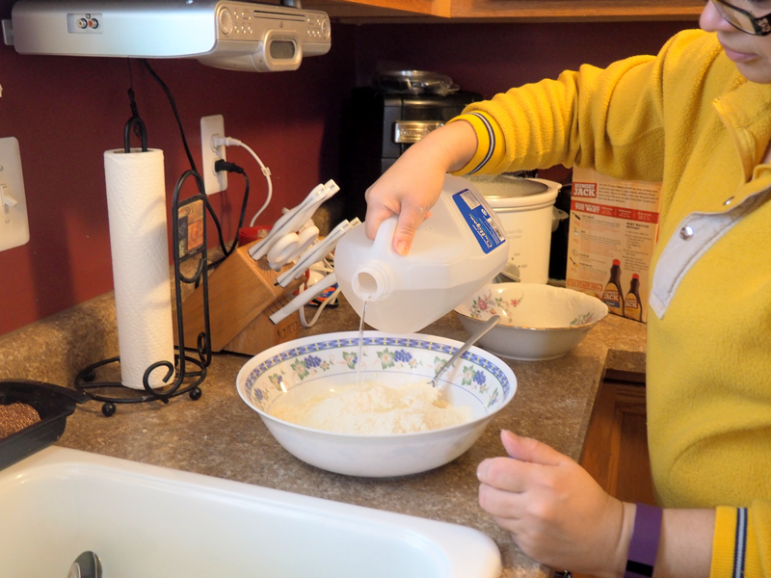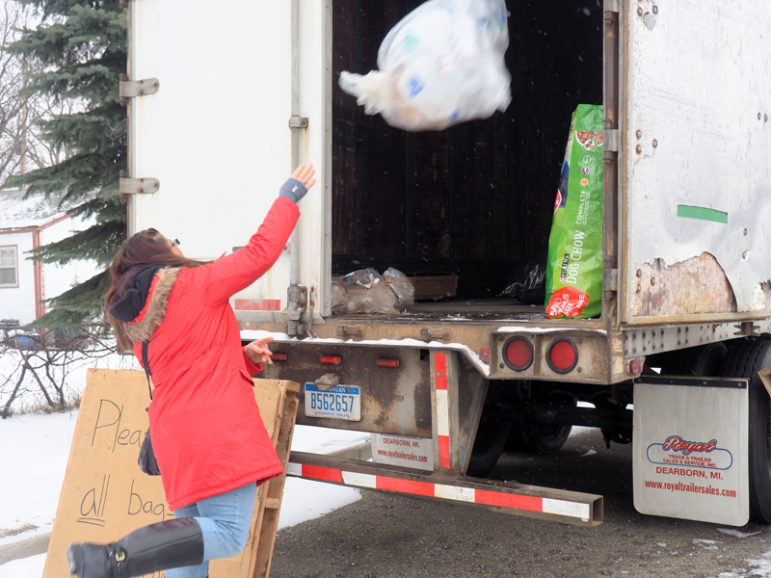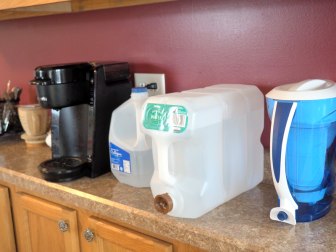By AMANDA PROSCIA
Capital News Service
FLINT — The view from the driveway is surprisingly normal: there is snow on the ground, the neighbors’ children are playing basketball in the street and the landscaping is meticulously manicured.
Inside, family pictures adorn the walls, a television hangs above the fireplace and several houseplants complement the décor. This house could be any suburban home in the country.
Except…various-sized water bottles fill drawers and cover countertops, and cases of bottled water are stacked in the mudroom.

Angel Garcia pours water supplied by the National Guard into his coffee maker. Credit: Amanda Proscia
This is the home of Angel and Edeline Garcia, residents of Flint for the past 15 years and now victims of that city’s water crisis.
They can no longer drink or cook with their tap water because of high levels of lead dissolving from the city’s water pipes after a disastrous decision to switch its water supply to save money.
“Would you like something to drink?” Angel Garcia recently asked a visitor. “We don’t use Flint water.”
He chuckled at the hesitant but polite decline of the offer.
But it’s no laughing matter for the Garcias, who spend much of their day adjusting to life without tap water.
“Cooking is a real adventure,” Edeline Garcia said.
They can receive more water from the National Guard if they take the case of 24 bottles they’re allotted each day. But it’s just not practical to open a bunch of bottles to cook something. Instead, they often opt for the two one-gallon water jugs that are the alternative.

Edeline Garcia makes pancakes using water from the National Guard. Credit: Amanda Proscia
“Subconsciously I’ve been planning dinners that don’t require much water just to make it a little easier,” Edeline Garcia said.
They use the smaller bottles for drinking and brushing their teeth.
After picking up their daily allotment from the National Guard, they go to local churches for the 24 packs of water bottles. The churches often don’t limit how much water they give out. This day, volunteers at Our Lady of Guadalupe fill the Garcias’ entire trunk with cases of water.
The couple take a “pay it forward” approach to gathering water — most of the time only keeping one of the many cases they receive, dropping off the rest to their pregnant daughter or people they know who have children.
They keep enough on hand to avoid daily trips to the distribution center, a firehouse a few blocks away.
They travel there for more than replenishing their water supply. Each week they take a large clear plastic bag filled with empty water bottles to dump into an 18-wheel truck trailer with a recycling sign hanging on it. Until now, the city lacked a recycling program. When the truck is full, city officials drive it to a recycling plant.
“I feel like I’m in a foreign country — not being able to drink the tap water — but I am in my own country,” said Angel Garcia, as he slowly poured a bottle of water into his coffee machine. His frustration is apparent in his voice.

Edeline Garcia tosses a week’s worth of empty plastic bottles into the recycling trailer. Credit: Amanda Proscia
Garcia is a pastor at the Grace Bible Church in nearby Grand Blanc. He is enthusiastic and charming. He opens the car door for his wife every time they stop to pick up cases of water and he helps strangers carry their cases from the water stations to their trunks.
Flint residents cope with the water crisis in different ways, he said. The Garcias bought a whole house water filtration system to feel comfortable using tap water to bathe and wash clothes. It is rare to get lead poisoning through the skin, but the Garcias said Flint’s water tinted their laundry.
Some people joined a gym in the next town for $10 a month to be able to shower with clean water, he said.
The crisis makes Edeline Garcia question all of her household’s health ailments.
After she complained of stomach pains for about a week, her doctor diagnosed her with H. Pylori, an ulcer-causing bacteria often found in areas with unclean water or faulty sewage systems, she said.

Various forms of water on the Garcias’ countertops. Credit: Amanda Proscia
They gave their two cats and one dog tap water until one cat died mysteriously at 8 years old.
“I know there’s no way to tell it was the lead,” Edeline Garcia said, her eyes glassy. “It’s just always in the back of your head when anything happens.”
She now gives her surviving pets bottled water.
At Flint residents’ expense
Although they’ve known about the lead in the water for more than a year, the Garcias say they only received free bottled water after Gov. Rick Snyder brought in the National Guard in January.
Before then, it was a considerable expense.
Flint’s average household income is around $25,000, and more than 40 percent of the city’s residents live below the poverty line — almost two and a half times as many as the state’s average, according to the most recent U.S. Census.
Buying water for drinking, bathing and cooking for more than a year was a significant portion of the residents’ income.
“Grocery stores like Kroger reduced the price of the bottled water to just be the cost to try to help out the Flint residents,” Edeline Garcia said. “But it still was a big expense for us.”
These are points the Garcias plan to make at a meeting to discuss a class action lawsuit. They are among the more than 5,000 Flint residents who have joined the lawsuit directed at city, state and federal officials. Clean water crusader Erin Brockovich is leading that effort.
“We don’t even want the money, we just want someone to be held accountable for what has happened to us,” Edeline Garcia said.
Lead in Flint’s Latino community
The Garcias are active members of Flint’s Latino community, which they say has faced unique obstacles during the water crisis.
The National Guard first required identification before delivering water to residents. Many undocumented Flint residents thought it was a trap and would not accept water until identification was no longer required, Angel Garcia said.
The language barrier was another problem.
Since there are no Spanish-speaking local news channels in Flint, many Latino residents were unaware of the lead in the water until it became a national news story, according to Edeline Garcia.
A pregnant woman who only spoke Spanish had been drinking tap water for more than a year before learning it was unsafe, said Ralph Arellano, head of operations at the Hispanic Technology Center.
Researchers say there is a direct correlation between fetal death rates and drinking lead contaminated water. Fetal deaths climbed more than 30 percent when there was a dangerously high level of lead in Washington, D.C.’s water. They dropped to normal once water lead levels dropped.
Effects on Flint’s kids
Mountains of cases of water bottles line the hallways and tower over the toddlers attending Flint’s Alpha Montessori School.
Children are especially susceptible to lead. It impacts their health for the rest of their lives and harms their economic success.
Kids exposed to lead in drinking water earn less as adults and are less likely to own a home than children not exposed to lead, according to Werner Troesken, an economics professor at the University of Pittsburgh and one of the researchers on a study linking lead ingestion with decreased economic success.
All that research makes Flint’s school administrators extra cautious with drinking water.
“It would take serious data from studies to show that the lead levels are safe before we would ever trust the water for the kids to drink,” said Katie Cawood, administrator at Alpha Montessori.
Until that comes, the drinking water fountains are out of commission – most of them covered by cases of water bottles. Schools stockpile bottled water because they don’t know how long the crisis will last or how long the water donations will continue, Cawood said.
“We have lots of water but no long term ideas or solutions — and that’s essential.”
We could be Flint
A similar disaster could have happened to most major U.S. cities, Troesken said.
“Lead services lines are most likely to be found in cities that were built prior to the 1940s,” said Enesta Jones, a press officer for the Environmental Protection Agency. “There are an estimated 10 million lead service lines across the country.”
Flint’s problem happened when city officials switched to the Flint River, which is a more acidic water source. Left untreated, the acidic water corroded the city’s lead service pipes, causing the lead they contain to seep into Flint residents’ tap water.
Anti-corrosion water treatment to prevent lead from leaching would have cost about $100 a day, according to Marc Edwards, the lead researcher for the Virginia Tech University lab that found the high levels of lead in Flint’s water.
If any of these other cities switch their source of water to a more acidic supply without treating the water, the pipes would corrode and lead would be found in the water, Troesken said.
The extent of the problem is unclear. The closest thing to a national map of lead service lines in the country is one Troesken compiled from his economic study. It uses data from the U.S. census to map lead, mixed and non-lead lines.
“Forty-four of the 50 largest cities in the U.S. use lead pipes fully or in combination with non-lead pipes,” Troesken said.
The map only plots the service lines in the cities included in the study.
A city of skepticism
A cloud of distrust of the government and uncertainty about Flint’s future plagues many of the city’s residents.
“Even if officials say the water is safe to drink in six months, we’re probably going to wait a few years,” Angel Garcia said.
Arellano agrees.
“This water crisis just shows the horrible, evil things they’ve done to save a few dollars.”
The multiple missteps made by local, state and federal officials make Flint residents wary of the help they offer.
“They have to do more than rebuild the lines, they have to rebuild the trust,” Angel Garcia said.
Nonetheless, the Garcias remain optimistic.
“Flint is going to get better because you can only get so low and I think we really hit bottom with the water thing — there’s nowhere to go but up for right now,” Angel Garcia said.
Amanda Proscia writes for Great Lakes Echo.